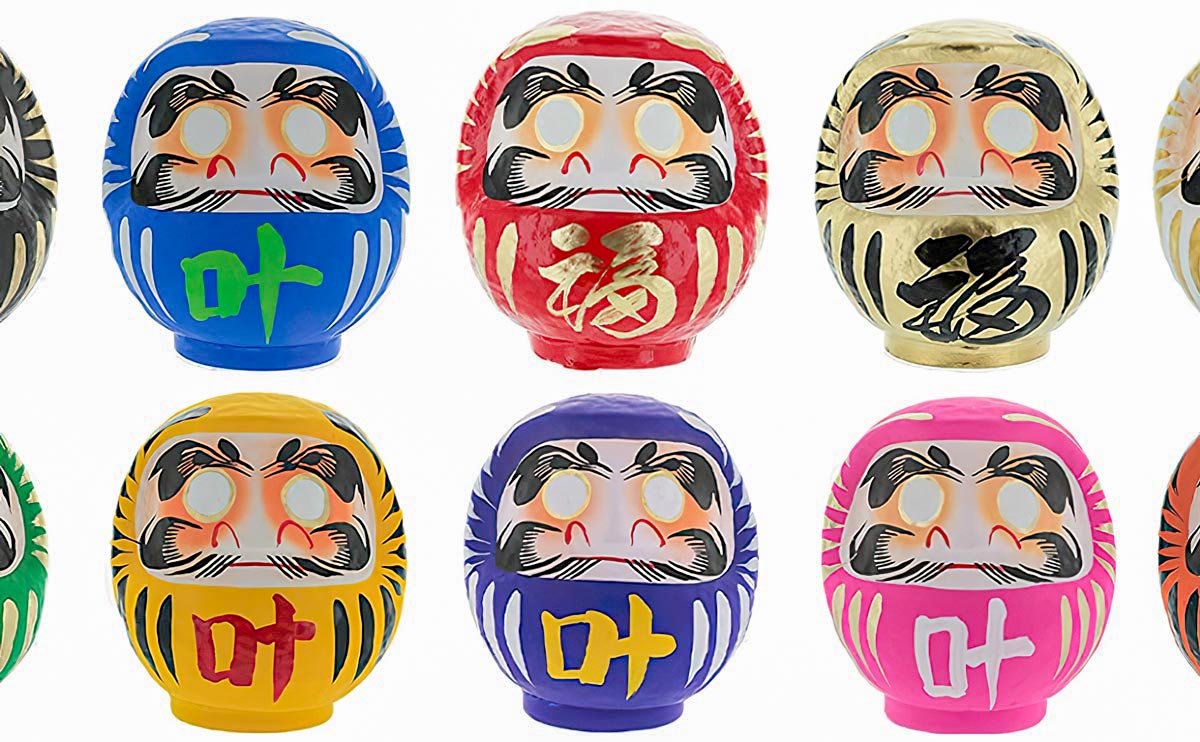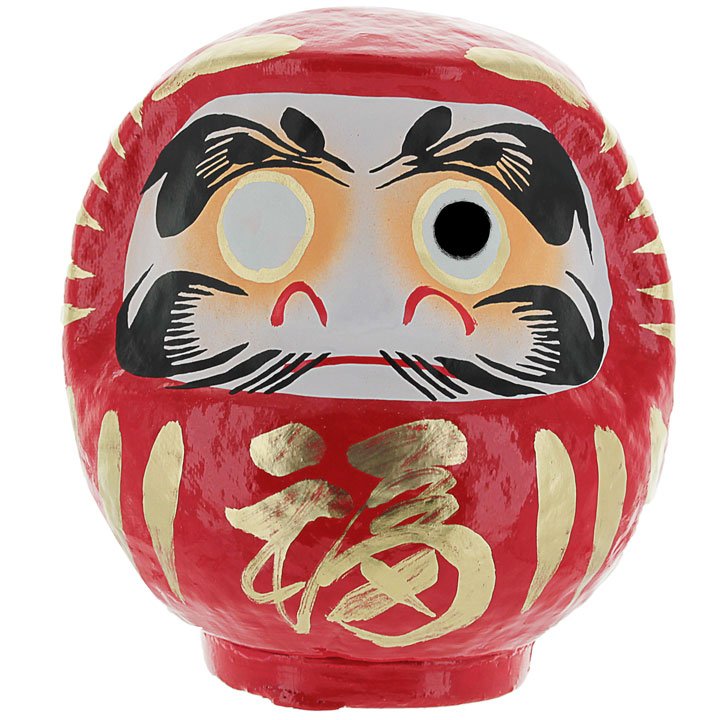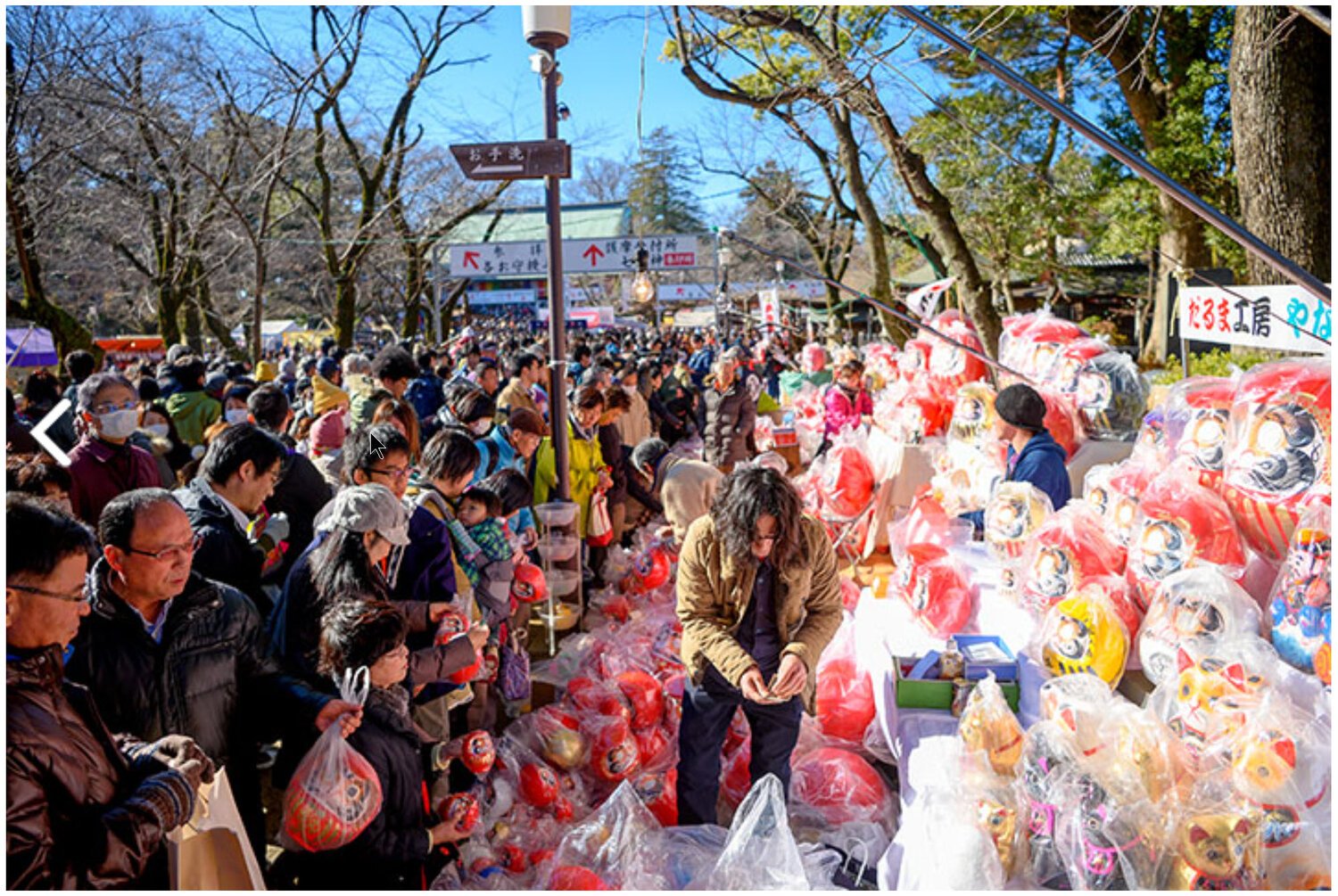History of Daruma Dolls
What is a Daruma doll?
The Daruma doll, a traditional symbol of fortune in Japanese culture, is often used as a talisman for making a wish or setting a personal goal.
Daruma is typically round, crafted with layers of paper mache, and decorated by an artisan who brings life to its facial features, body, and other ornamental aspects. The doll's eyes, however, are deliberately left blank.
This unfinished detail serves a unique purpose for the owner embarking on the Daruma tradition:
The first step is to set an intention, whether a goal, a wish, or a promise to be kept.
Next, one eye of the Daruma is filled in with a round dot (it can be either eye, but the doll's left eye is often recommended).
From there, strive to achieve the goal.
Once the objective has been reached, or the wish has come to fruition, the other eye is painted in.
Daruma dolls permeate Japanese society and can be spotted adorning the shelves or altars of residences, businesses, dining establishments, and places of worship. This is a testament to the deep-seated integration of good luck charms in Japanese style and everyday life.
In addition to the Daruma, other symbols of good luck in Japan include the maneki neko, omamori, omikuji, and senbazuru.
Meaning of a Daruma doll
Daruma dolls serve as enduring symbols of what the Japanese call the ganbaru spirit, the capacity to endure and persist.
Life is inevitably riddled with challenges, obstacles, and missteps. We are bound to trip, make errors, and suffer losses.
However, the act of rising, having faith in the journey, and persisting in our endeavors is what the Daruma doll symbolizes. It encapsulates the well-known Japanese proverb, Nanakorobi yaoki, which translates to "Fall seven times, stand up eight."
Despite fatigue, the lengthy road ahead, and varying circumstances, the ganbaru spirit marches on. Enlightenment is reserved for those who pause to reflect on their evolution from dreamer to doer.
This is why Daruma dolls exhibit such resolute expressions. Some might even interpret them as appearing angry. They personify tenacity, always bouncing back when knocked down.
The Daruma doll is a manifestation of perseverance.
Daruma dolls belong to a broad category of self-righting toys known as okiagari-koboshi.
Daruma doll colors explained
The traditional color of Daruma dolls is red, a choice rooted in their historical significance (see sub-section ‘In Japanese History’). However, contemporary iterations of Daruma dolls showcase various colors and patterns.
The interpretation of Daruma colors is largely subjective and left to the user's discretion, as there's no universally accepted standard. That said, the creators of Daruma dolls have provided guides to help customers associate specific colors with particular goals and wishes.
It's important to acknowledge that scholars and craftspeople specializing in Daruma dolls have their unique interpretations for each color. Therefore, what is presented here should be viewed as one possible interpretation, not an absolute truth, despite our thorough research and earnest efforts to gather accurate information.
Red Daruma doll
Meaning: Good luck and well wishes.
Recommended for: General wishes.
Gold Daruma doll
Meaning: Wealth and prosperity.
Recommended for: Anything related to money.
White Daruma doll
Meaning: Purity and peace.
Recommended for: Wellness: mental, spiritual, physical, etc.
Purple Daruma doll
Meaning: Improvement and enlightenment.
Recommended for: Building up a new personality or trait.
Blue Daruma doll
Meaning: Success and performance.
Recommended for: Success in career, job, or business ventures.
Pink Daruma doll
Meaning: Heart & emotions.
Recommended for: All things heart.
Green Daruma doll
Meaning: Wellness & growth.
Recommended for: Being in prime physical condition.
Orange Daruma doll
Meaning: Learning & potential.
Recommended for: Better mind, better concentration, and results.
Yellow Daruma doll
Meaning: Support & warmth.
Recommended for: Friendship and honor in relationships.
Black Daruma doll
Meaning: Power & protection.
Recommended for: Warding off all evil.
Silver Daruma doll
Meaning: Sophistication and status.
Recommended for: Showcasing a personal or professional transformation.
Unpainted Daruma doll
Meaning: Create your own design and purpose.
Recommended for: Releasing the artist inside.
The interpretation of colors ultimately rests on the owner, but the above guidelines can provide direction when faced with an overwhelming array of choices. Acrylic or watercolor paints are the most effective when decorating unpainted Daruma dolls. However, we’ve observed designs that utilize crayons, washi (Japanese paper), dried flowers, and even gold leaf.
Commercially available Daruma dolls come in many sizes, ranging from the diminutive 2.3-inch models to the colossal 29.5-inch ones. However, the 4.7-inch (12cm) model seems to be the most favored choice among consumers.
Daruma doll design & symbols explained
Given that Daruma dolls stand for perseverance, their designs should symbolize enduring existence.
The eyebrows are fashioned to look like cranes, and the facial hair is designed to resemble turtle shells. These symbols carry significant meaning, with the crane representing 1,000 years and the turtle shell symbolizing 10,000 years.
Although the Daruma doll's expression may seem fierce, angry, or stern, it is a depiction of determination as the owner strives towards their goal. No task is simple, yet no challenge is insurmountable.
Both eyes of the Daruma are left uncolored. The user is to fill in one eye after setting a goal or making a wish and then paint the other once the goal has been achieved. Drawing the eyes symbolizes breathing life and soul into the Daruma, akin to "opening the Daruma doll's third eye."
The Daruma doll is more than just a toy. It is a tangible embodiment of your goals, the hand of destiny or faith, and everything in between. Most importantly, it holds you accountable.
So which Daruma doll eye should be drawn first?
Though it's acceptable to start with either eye, there's a common belief that the proper approach is to paint the Daruma's left eye first (from the doll's perspective or the right eye from your viewpoint).
This practice has roots in various reasons, one of which is the traditional Japanese seating arrangement where the position on the left is often accorded higher status.
Nonetheless, there isn't a strict rule on which eye to color first. The crux of the matter is to set a goal or make a wish, and commit to achieving it with sincerity.
The aim is to achieve 目が出る (megaderu), a phrase that refers to having luck on one's side. Yet, its literal translation is "eyes open", a nuanced reference to the Daruma doll's Buddhist origins hinting at enlightenment, and also to the individual on whom Daruma dolls are modeled.
Daruma kanji meanings.
A single kanji, a symbol of Japanese writing, is usually emblazoned on the Daruma doll's midsection.
While any kanji, letter, or character could be employed, three kanji are frequently chosen for traditional, non-customized Daruma dolls:
福 (fuku): This stands for blessing, fortune, or luck.
幸 (shiawase): This denotes happiness, blessing, or fortune.
叶 (kanau): This signifies to come true, to be realized, or to be fulfilled.
Additional kanji can be inscribed on each shoulder of the Daruma doll to articulate a specific goal or deliver further words of encouragement.
History of the Daruma doll and its legend
The Man & The Myth
Daruma dolls draw inspiration from a revered monk named Bodhidharma, who lived during the 5th-6th century. He was renowned for his immense commitment to meditation and asceticism, enhancing his stature over time.
As with many historical, spiritual, and religious figures, there exists both the factual persona and the colorful folklore surrounding them, the latter often expanding with each passing generation.
One such tale recounts how Bodhidharma spent nine years in intense meditation, gazing unwaveringly at a cave wall, his eyes perpetually open without a single blink. Despite his body, arms, and legs atrophying and deteriorating due to his relentless pursuit of enlightenment, his spirit remained steadfast and unyielding.
As a result of this allegory, Bodhidharma's popularity surged, spreading from China to Korea, Southeast Asia, and eventually Japan.
Moreover, he's often credited with bringing Zen Buddhism to China, establishing Shaolin Kung Fu, instituting Zazen meditation, and introducing green tea – quite an impressive list of achievements.
In Japanese History
In Japan, the inception of Daruma dolls can be traced back to the early Edo period (early 1600s) when these dolls were created as talismans to safeguard children from smallpox and measles. The maladies were attributed to a malevolent demon.
The so-called smallpox devil was believed to harbor a fear of the color red, which led to the widespread display of red Daruma dolls in the belief that "red draws in red". This belief helped foster the magical and mythical powers associated with Daruma dolls.
Alternatively, some theories propose that the red color of Daruma dolls symbolizes fire, blood, and celebration, as red is considered a lucky color in several Asian cultures.
Regardless of the exact origin of their red color, Daruma dolls transitioned from serving as protectors against smallpox to defenders of children, promoters of successful childbirth, and harbingers of abundant harvests, and they are now seen as symbols of good fortune.
The 17th-18th century farmers are often acknowledged for shaping the Daruma doll's modern demand and supply dynamics. They viewed these dolls as lucky charms ensuring a prosperous rice harvest. These dolls were initially crafted from wood by Buddhist monks.
Over time, the farmers learned to produce their own Daruma dolls using molds. In their idle seasons, they would manufacture Daruma dolls as a supplementary trade. Fast-forwarding a couple of centuries to the present day, Daruma dolls are now made from papier-mâché and their protective scope has expanded from children to general good luck.
The Hidden History
Endowed with the ability to "spring back up with great vigor", the Daruma took on sexual connotations during the Edo period, particularly among the lower social strata.
Craftsmen with a penchant for satire began to fashion Daruma dolls into phallic forms.
The term 'Daruma' was also used to describe prostitutes, a nod to their ability to "fall down" and elicit a "rise" from their clients.
Artists creatively depicted Daruma as a woman, a prostitute, or even cross-dressing, subtly suggesting Daruma's potential for fluidity in sexual orientation.
Indeed, Daruma can be seen as a universal symbol, embodying all genders.
Despite the playful satire, the female Daruma doll eventually became a mainstream collectible item. The 'hime Daruma' (princess Daruma) and 'anzen Daruma' (safety Daruma) are often presented to pregnant women as amulets to ensure safe and uncomplicated childbirth.
Daruma doll manufacturers
Takasaki, located in Gunma, is the primary hub for Daruma doll production.
The city is responsible for approximately 80% of all Daruma doll output in Japan, boasting over 50 artisan families in Gunma who collectively produce over a million Daruma dolls annually.
The remaining 20% of Daruma production is spread across Japan's 47 prefectures, each lending its distinct regional designs to the dolls. For example, the Shirakawa Daruma is a bit taller and less rounded than other designs.
Daruma doll in popular culture
The influence of Daruma and Daruma-like motifs is evident in countless places.
Iconic Japanese characters such as Hello Kitty, Doraemon, and Super Mario often receive a Daruma-inspired makeover for a charmingly cute (or 'kawaii') aesthetic.
This influence also touches international brands, including Star Wars, Nike, and Lego.
Daruma's presence is apparent in numerous anime and video games like One Piece, My Hero Academia, Pokemon, and The Legend of Zelda, either directly or indirectly.
Even the Japanese term for a snowman is 'yuki-Daruma', translating to 'snow Daruma'. There's also 'Daruma otoshi', a traditional Japanese children's game that involves knocking out wooden blocks one at a time while trying to prevent the Daruma from toppling over.
Daruma festivals
There are various daruma fairs around the country. The three most famous are:
Shorinzan Daruma Festival
Believed to be the birthplace of daruma dolls, over 50 of Takasaki’s finest Daruma craftsmen show up with their absolute best.
Hundreds of Daruma decorate the temple, adding to the atmosphere of hope and dreams.
Location: Shorinzan Darumaji Temple in Takasaki, Gunma
Date: January 6-7th.
Website: https://www.daruma.or.jp/
Bishamonten Festival
With over 500,000 visitors and more than 150,000 dolls sold in a three-day period, Bishamonten Festival is a definitive Daruma experience, especially with Mount Fuji in the background.
Festival includes a bonfire ritual, special prayers, food stalls, and shopping for other good luck amulets.
Location: Bishamonten Temple in Fuji, Shizuoka.
Date: 3 days in February.
Website: http://www.fuji-bisyamonten.com/index.html
Jindaiji Temple Daruma Fair
With over 300 open stalls, the Jindaiji Temple Daruma Fair is a sizeable fair located in the greater Tokyo prefecture. As the second oldest Buddhist temple in Tokyo, it holds much historical and spiritual value.
Festival includes a procession of temple monks colorfully dressed while performing ancient songs and hand-drawn eyes painted in by a monk.
Location: Jindai-ji Temple in Chofu, Tokyo
Date: March 3rd-4th.
Website: https://www.jindaiji.or.jp/event/darumaichi.php
Other notable Daruma fairs include:
Maebashi Hatsuichi Matsuri
One of the oldest (since early 1600s) and biggest (over 600 shops), the Maebashi Hatsuichi Matsuri is a grand celebration of all things Daruma.
Festival includes a bonfire ritual for completed Daruma wishes, public parades, food stalls, shopping, and new years celebrations.
Location: Honmachi Street in Maebashi, Gunma
Date: January 9th.
Website: https://www.maebashi-cvb.com/event/2001
Kawagoe Daruma Festival
Held on January 3rd, the festival is a New Year’s celebration. A new year brings new goals; therefore, Daruma dolls perfectly embody a new year’s resolution.
Kawagoe is a historical town with Edo-style buildings. Therefore Kawagoe Daruma Festival features traditional sights, sounds, and eats.
Location: Kitain Temple in Kawagoe, Saitama
Date: January 3rd.
Website: https://kitain.net/
Other questions about Daruma
Is it possible to reuse a Daruma doll?
Once an eye has been filled in to signify a wish, the Daruma doll becomes spiritually bound to that wish. Although there's no strict rule preventing the reuse of a Daruma doll, it's generally not advised.
What happens if your wish doesn't come true?
In Japanese culture, the concept of kaizen, or continuous improvement, is highly regarded. Therefore, an unfulfilled wish often serves as a motivation for the person to continually strive for improvement. For more specific wishes, the Daruma doll may serve as a reminder of unmet goals, reinforcing the idea that success is born out of failure.
What do you do once your wish comes true?
When a Daruma doll has both eyes filled in and the associated goal or wish is fulfilled, it's customary to return the doll to a local temple where it becomes part of a bonfire ritual. The fire consumes the doll, liberating its spirit and sending it back to the heavens.
Do you need to burn a completed Daruma doll?
Although it's generally recommended, burning a completed Daruma doll is not mandatory. The importance lies in the sincerity of your intention.
How can I make my own Daruma doll?
Since Daruma dolls are made using paper mache, standard paper mache techniques should suffice for creating your own homemade Daruma. Unpainted Daruma dolls are also available if you're eager to start the coloring and design process immediately.










